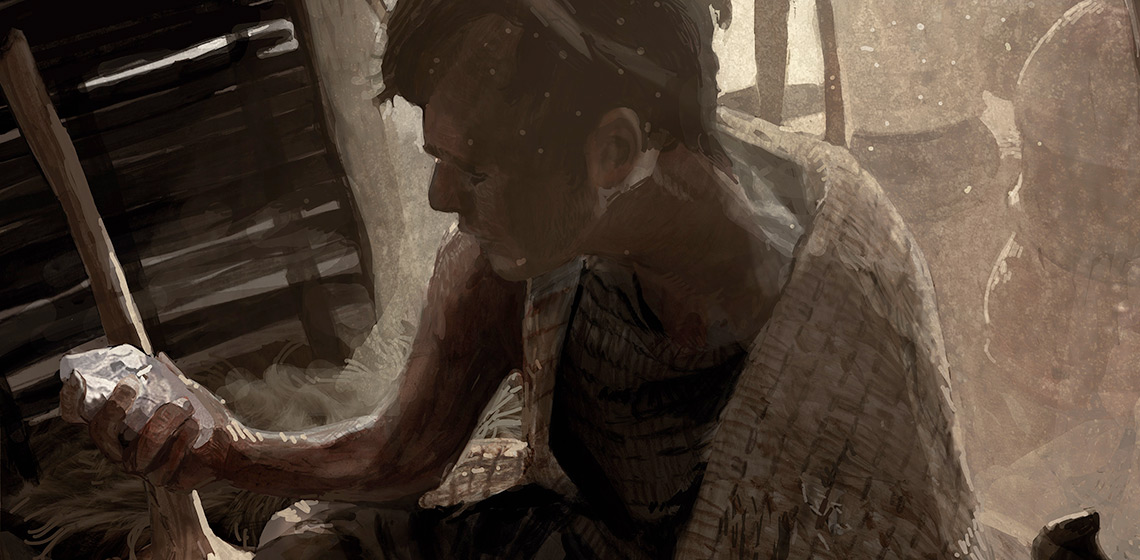The content is published under a Creative Commons Attribution Non-Commercial 4.0 License.
Unreviewed Mixed Matters Article:
Call for information: Recycling in the Late Neolithic at the Vlaardingen site of Den Haag-Steynhof

The Putting life into Late Neolithic houses project looks at all the different aspects of what life could have been like for “the people in the Rhine/Meuse delta at about c. 2900 – 2500 BC.” (www.puttinglife.com). This is not only done by academic research, experiments, and material analysis, but also through illustrations produced by archaeological reconstruction illustrator Kelvin Wilson.
Based on archaeological research and finds, as well as the input of the team who share their knowledge of prehistoric tools, pottery and Neolithic life with him, Kelvin brings crucial moments of the Vlaardingen people to life in his drawings. The second visualisation focuses on the aspects of repairing and recycling material.
The research has demonstrated that some of the Vlaardingen sites show a considerable amount of evidence for repair and recycling. This is not only visible in the flint assemblage, but also pottery from the Den Haag-Steynhof site. More information on the Den Haag-Steynhof site can be found in the site report Een Vlaardingennederzetting in het Wateringse Veld (2021) by R. J. van Zoolingen en E. E. B. Bulten (eds).
“Large quantities of polished axe fragments” (van den Dikkenberg 2022) were found during analyses in the lab. These analyses have also provided an answer to the origin of the axes. They are “most likely made of Hesbaye flint” (van den Dikkenberg 2021). The theory is that the flint “may have been scarce and have constituted a valuable raw material”. This would explain why the flakes were not thrown away when an axe broke but were recycled and reused for other purposes. The person in the visualisation is holding a “wooden handle with antler sleeve in which a remnant of a broken axe is visible”. The drawing helps to visualise the findings of van den Dikkenberg’s research and analyses.
However, flint is not the only material which seems to have been recycled or re-used. During the research, the team have come across evidence that pottery was also repaired. They have found repair holes on some of the sherds of Vlaardingen pottery. This can usually be observed on the rim or the upper parts of the pots. These perforations have a conical or biconical shape, very different from the cylindrical ones that were made prior to firing of the pottery. Experiments with making such holes with flint drills show these to be effective. The resulting wear traces closely match those seen on the archaeological flint drills from Steynhof, indicating that these tools were involved in pottery repair. This observation also found its way into the illustration. In the background, lime bast is visible as a possible binding material for the repair of the pots.
The following questions came up during the research undertaken examining everyday life of the Vlaardingen culture, at sites like Den Haag-Steynhof and the making of the visualisation. The team would like to use these questions to start a discussion:
- Have you also found evidence for recycling and repair at your sites?
- What are your ideas or experiences with drilling fired pottery?
- Can you think of reasons to repair pottery? Have you found evidence for such repairs in other contexts?
The team welcome your input and experience. You can get in touch with them via EXARC.
All copyright of the illustration lies with Kelvin Wilson and the University of Leiden.
Country
- the Netherlands
Bibliography
Van den Dikkenberg, L. 2022, ‘How to finish your axes? Experiments with the final stages of the production of polished flint axes’, blog post, Putting Life into Late Neolithic Houses, https://www.puttinglife.com/blog/how-to-finish-your-axes-experiments-with-the-final-stages-of-the-production-of-polished-flint-axes/ [Last accessed 3 October 2022.]
Van den Dikkenberg, L. 2021, ‘Kill your darlings, making and breaking flint Buren axes’, blog post, Putting Life into Late Neolithic Houses, https://www.puttinglife.com/blog/kill-your-darlings-making-and-breaking-flint-buren-axes/ [Last accessed 12 October 2022.]
Van Gijn, A.L. and J. A. Bakker 2005. Megalith Builders and Sturgeon Fishers. Middle Neolithic B, Funnel Beaker Culture and the Vlaardingen Group. In L. P. Louwe Kooijmans, P. W. Van der Broeke, H. Fokkens and A. L. Van Gijn, The Prehistory of the Netherlands, vol. 1, Amsterdam University Press, Amsterdam, 281-306
Van Zoolingen, R. J. and Bulten, E. E. B. (eds.) 2021. Een Vlaardingennederzetting in het Wateringse Veld. Haagse Oudheidkundige Publicatie 23. Afdeling Archeologie & Natuur- en Milieueducatie Dienst Stadbeheer. https://archeologie.denhaag.nl/wp-content/uploads/2022/02/HOP23_Steynhof-Anne-Frankpark-Een-Vlaardingennederzetting-in-het-Wateringse-Veld-web.pdf [Last accessed 12 October 2022]
Project website: www.puttinglife.com

